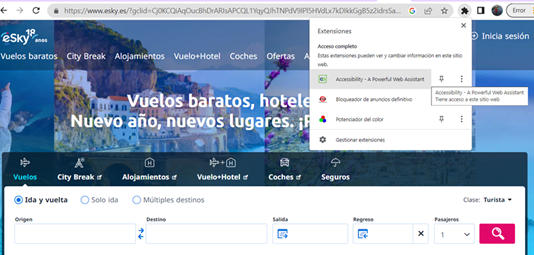Strumenti per una navigazione più agevole
Hai mai sentito parlare di accessibilità web?
In base alla definizione fornita da W3.org:
“L’accessibilità web è un parametro per cui i siti web, gli strumenti e le tecnologie sono progettati e sviluppati in modo tale che le persone con esigenze speciali possano utilizzarli. Più precisamente, gli utenti possono:
- percepire, comprendere, navigare e interagire online
- contribuire allo sviluppo del web”
In tal senso, un web accessibile serve non solo alle persone con esigenze speciali ma anche a coloro con limitazioni temporanee o situazionali (ad esempio, un braccio rotto o occhiali persi; cambiamenti delle abilità dovuti all’avanzare dell’età; luce solare intensa o ambienti troppo rumorosi; connessione Internet lenta o schermo piccolo, etc.)
Nella descrizione di alcune delle principali caratteristiche delle piattaforme di prenotazione, abbiamo sottolineato la facilità d’uso e la semplicità di navigazione delle piattaforme. La maggior parte dei grandi brand fa del suo meglio per essere accessibile e adattare le caratteristiche del sito web alle esigenze degli utenti. Tuttavia, molti siti talvolta non riescono a soddisfare i requisiti di accessibilità più importanti: buon contrasto cromatico, sito web responsivo (ovverossia adattabile alle dimensioni dello schermo, da pc a smartphone a tablet), caratteri leggibili, disponibilità di sottotitoli nei video e alternative testuali per le immagini, funzionalità della tastiera, etc.
Fortunatamente, in qualità di utenti di Internet, possiamo migliorare l’accessibilità della rete tramite le impostazioni del browser, personalizzazioni ed estensioni.
Quando abbiamo parlato di come verificare la sicurezza di un sito web, abbiamo menzionato l’URL. L’indirizzo URL viene inserito nel browser, consentendoci di navigare online. I browser più popolari e ampiamente utilizzati sono Google Chrome, Mozilla Firefox, Microsoft Edge, Apple Safari e Opera. A volte, è più utile personalizzare le impostazioni del computer o della piattaforma (Windows, macOS, Android e iOS).
Un’estensione del browser è un piccolo software che aggiunge funzioni personalizzate al browser principale, come la modalità scura, il correttore ortografico, il blocco degli annunci pubblicitari e altro ancora.
Anche se i browser e le piattaforme sono diversi, tutti offrono funzioni di accessibilità simili:
- Aumentare la dimensione del carattere per adattarsi alle proprie esigenze di lettura senza modificare le immagini o altri media
- Applicare lo zoom per ingrandire tutte le parti dello schermo. Nel browser, la pagina può essere ingrandita fino al 500%
- Utilizzare la modalità di alto contrasto che inverte i colori in modo da renderli più facili da leggere per chi ne abbia bisogno
Se non riesci a trovare alcune di queste funzionalità nelle impostazioni del tuo browser, puoi cercare nelle impostazioni del sistema operativo. Un’altra opzione è quella di aggiungere alcune estensioni al tuo browser.
Di seguito ti offriamo alcune delle estensioni che possono migliorare l’accessibilità di una pagina web:
1. Helperbird
L’applicazione dispone gratuitamente di una vasta gamma di strumenti per personalizzare la pagina web secondo le tue esigenze e migliorarne l’accessibilità:
- Funzioni del testo: caratteri specializzati per la lettura; caratteri per la dislessia; allineamento del testo; spaziatura tra parole e lettere.
- Funzioni di contenuto: modalità lettura; Microsoft Immersive Reader (migliora la lettura); rimuove annunci e distrazioni da qualsiasi pagina; dizionario delle immagini; Google traduce in oltre 100 lingue.
- Funzioni di visualizzazione: evidenzia i collegamenti; controlli per il daltonismo; nasconde le immagini.
- Funzioni di lettura ad alta voce: dispone di una tipologia di tecnologia assistiva che legge ad alta voce i testi digitali; amplificatore del volume per audio e video sulla pagina.
- Funzioni cromatiche: evidenzia e seleziona i colori.
Visitando questo link, puoi installare questa estensione sul tuo browser Chrome e reperire una panoramica video di questo strumento. Se utilizzi un altro browser, verifica qui per l’installazione.
2. Accessibility – un potente assistente web (estensione Chrome)
Questo è uno strumento eccellente e gratuito da aggiungere al tuo browser che personalizzerà la navigazione in base alle tue esigenze con le seguenti funzioni:
- Regolazione del carattere – ti consente di cambiare il carattere e il grassetto.
- Blocco animazione – ti consente di disattivare tutte le fastidiose animazioni sulla pagina web.
- Contrasto cromatico – ti consente di cambiare lo sfondo predefinito, il testo e i link.
- Text-to-speech (ovvero lettura ad alta voce)– ti consente di disporre di lettura ad alta voce del testo evidenziato con più di 200 impostazioni vocali.
- Tinte e sovrapposizioni – un righello sovrapposto che ti consente di seguire facilmente il testo sullo schermo e bloccare contenuti fuorvianti.
Puoi scaricare qui lo strumento e verificarne la configurabilità per il tuo browser web.

3. Ultimate Ad Blocker (estensione Chrome, disponibile anche per Firefox)
Si tratta di uno strumento gratuito che consente di bloccare annunci pubblicitari, banner, pop-up, pre-roll e altri annunci su diversi siti web, incluso YouTube. Puoi scaricarlo e installarlo da qui.
4. Google Traduttore
Immagina di navigare il sito web ufficiale di un hotel tedesco e la tua lingua madre non è disponibile. In questo caso, questo strumento gratuito ti sarà molto utile poiché ti offre la possibilità di visualizzare le traduzioni durante la navigazione. Basta fare clic sul pulsante di traduzione nella barra degli strumenti del browser per tradurre la pagina che stai visitando. Segui questo link per scaricare Google Traduttore.
Queste sono solo alcune estensioni che potrebbero tornare utili per migliorare l’esperienza web. Tuttavia, ce ne sono molte altre, puoi cercarle su Accessibility Chrome Web Store oppure su App Store.
